what difference potential is large enough to cause problems
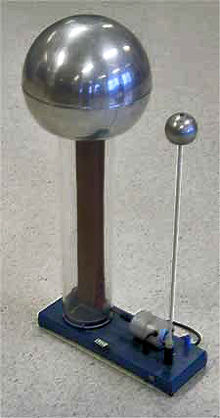 Small Van de Graaff generator used in scientific discipline education | |
| Uses | Accelerating electrons to sterilize food and process materials, accelerating protons for nuclear physics experiments, producing energetic X-ray beams in nuclear medicine, physics education, amusement |
|---|---|
| Inventor | Robert J. Van de Graaff |
| Related items | linear particle accelerator |
A Van de Graaff generator is an electrostatic generator which uses a moving belt to accrue electrical charge on a hollow metallic globe on the meridian of an insulated column, creating very loftier electrical potentials. It produces very loftier voltage direct electric current (DC) electricity at low electric current levels. It was invented by American physicist Robert J. Van de Graaff in 1929.[1] The potential difference achieved by modern Van de Graaff generators can exist as much as 5 megavolts. A tabletop version tin can produce on the order of 100 kV and can store enough energy to produce visible electric sparks. Modest Van de Graaff machines are produced for entertainment, and for physics instruction to teach electrostatics; larger ones are displayed in some science museums.
The Van de Graaff generator was developed as a particle accelerator for physics research; its loftier potential is used to accelerate subatomic particles to great speeds in an evacuated tube. It was the most powerful blazon of accelerator of the 1930s until the cyclotron was adult. Van de Graaff generators are however used equally accelerators to generate energetic particle and X-ray beams for nuclear inquiry and nuclear medicine.
Particle-beam Van de Graaff accelerators are ofttimes used in a "tandem" configuration: get-go, negatively charged ions are injected at one end toward the high potential last, where they are accelerated by attractive forcefulness toward the terminal. When the particles reach the concluding, they are stripped of some electrons to make them positively charged and are after accelerated by repulsive forces away from the terminal. This configuration results in two accelerations for the toll of one Van de Graaff generator and has the added advantage of leaving the complicated ion source instrumentation accessible near ground potential.
The voltage produced by an open up-air Van de Graaff machine is express by arcing and corona discharge to about v MV. About modern industrial machines are enclosed in a pressurized tank of insulating gas; these can attain potentials as big equally about 25 MV.
Description [edit]

Van de Graaff generator diagram
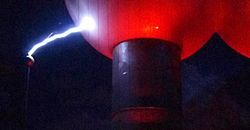
A simple Van de Graaff generator consists of a chugalug of rubber (or a similar flexible dielectric material) moving over two rollers of differing cloth, one of which is surrounded by a hollow metallic sphere. 2 electrodes, (ii) and (seven), in the form of comb-shaped rows of precipitous metal points, are positioned near the bottom of the lower roller and inside the sphere, over the upper roller. Rummage (ii) is connected to the sphere, and comb (7) to ground. The method of charging is based on the triboelectric effect, such that simple contact of unlike materials causes the transfer of some electrons from one material to the other. For example (meet the diagram), the prophylactic of the chugalug will go negatively charged while the acrylic glass of the upper roller will become positively charged. The belt carries away negative charge on its inner surface while the upper roller accumulates positive charge. Adjacent, the strong electric field surrounding the positive upper roller (3) induces a very high electrical field virtually the points of the nearby comb (two). At the points, the field becomes stiff enough to ionize air molecules, and the electrons are attracted to the outside of the chugalug while positive ions go to the comb. At the rummage (ii) they are neutralized by electrons that were on the comb, thus leaving the comb and the attached outer trounce (1) with fewer net electrons. By the principle illustrated in the Faraday ice pail experiment, i.due east. past Gauss'due south law, the excess positive charge is accumulated on the outer surface of the outer shell (1), leaving no field within the beat. Electrostatic induction by this method continues, edifice up very large amounts of charge on the beat.
In the example, the lower roller (six) is metallic, which picks negative accuse off the inner surface of the belt. The lower comb (seven) develops a loftier electrical field at its points that also becomes large enough to ionize air molecules. In this instance, the electrons are attracted to the rummage and positive air ions neutralize negative accuse on the outer surface of the chugalug, or get attached to the belt. The exact balance of charges on the upward-going versus down-going sides of the belt will depend on the combination of the materials used. In the case, the upward-moving belt must be more positive than the down-moving belt. Every bit the belt continues to move, a constant "charging current" travels via the belt, and the sphere continues to accrue positive charge until the charge per unit that charge is being lost (through leakage and corona discharges) equals the charging current. The larger the sphere and the further it is from ground, the higher will be its tiptop potential. In the example, the wand with metal sphere (8) is connected to ground, as is the lower comb (seven); electrons are drawn up from ground due to the attraction by the positive sphere, and when the electrical field is nifty enough (see beneath) the air breaks in the form of an electrical belch spark (9). Since the material of the chugalug and rollers can exist selected, the accumulated charge on the hollow metallic sphere can either exist made positive (electron deficient) or negative (excess electrons).
The friction type of generator described higher up is easier to build for science fair or homemade projects, since information technology does not require a high-voltage source. Greater potentials tin can be obtained with alternative designs (not discussed here) for which loftier-voltage sources are used at the upper and/or lower positions of the belt to transfer charge more than efficiently onto and off the chugalug.
A Van de Graaff generator terminal does non need to be sphere-shaped to work, and in fact, the optimum shape is a sphere with an in bend effectually the pigsty where the belt enters. A rounded final minimizes the electric field around it, allowing greater potentials to exist accomplished without ionization of the air, or other dielectric gas, surrounding. Outside the sphere, the electrical field becomes very strong and applying charges directly from the exterior would soon be prevented by the field. Since electrically charged conductors do not have any electric field inside, charges tin be added continuously from the inside without increasing them to the full potential of the outer beat out. Since a Van de Graaff generator can supply the same pocket-size current at almost whatever level of electrical potential, it is an case of a nearly ideal electric current source.
The maximal achievable potential is roughly equal to the sphere radius R multiplied by the electrical field E max at which corona discharges begin to form within the surrounding gas. For air at standard temperature and pressure (STP) the breakdown field is nigh 30 kV/cm. Therefore, a polished spherical electrode 30 cm in diameter could be expected to develop a maximal voltage V max = R·E max of nearly 450 kV. This explains why Van de Graaff generators are oftentimes fabricated with the largest possible diameter.

Van de Graaff generator for educational use in schools

With sausage-shaped top terminal removed
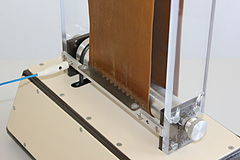
Comb electrode at bottom that deposits accuse onto belt
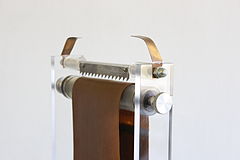
Comb electrode at top that removes accuse from belt
History [edit]


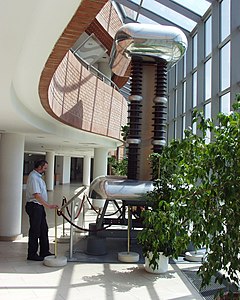
This Van de Graaff generator of the first Hungarian linear particle accelerator achieved 700 kV in 1951 and 1000 kV in 1952.

The concept of an electrostatic generator in which charge is mechanically transported in small amounts into the interior of a loftier-voltage electrode originated with the Kelvin h2o dropper, invented in 1867 by William Thomson (Lord Kelvin),[2] in which charged drops of water fall into a bucket with the same polarity charge, adding to the charge.[3] In a machine of this type, the gravitational force moves the drops confronting the opposing electrostatic field of the saucepan. Kelvin himself first suggested using a belt to carry the charge instead of water. The first electrostatic machine that used an endless belt to send charge was constructed in 1872 by Augusto Righi.[1] [3] Information technology used an india condom chugalug with wire rings forth its length as charge carriers, which passed into a spherical metal electrode. The accuse was applied to the chugalug from the grounded lower roller by electrostatic induction using a charged plate. John Greyness also invented a chugalug machine nigh 1890.[iii] Some other more complicated belt automobile was invented in 1903 by Juan Burboa[one] [4] A more immediate inspiration for Van de Graaff was a generator West. F. Grand. Swann was developing in the 1920s in which charge was transported to an electrode past falling metal balls, thus returning to the principle of the Kelvin h2o dropper.[1] [5]
The reason that the charge extracted from the chugalug moves to the outside of the sphere electrode, though information technology already has a high charge of the same polarity, is explained by the Faraday water ice pail experiment.[vi]
The Van de Graaff generator was developed, starting 1929, past physicist Robert J. Van de Graaff at Princeton University with a fellowship, with help from colleague Nicholas Burke. The commencement model was demonstrated in October 1929.[ citation needed ] [7] The first automobile used an ordinary tin tin, a small motor, and a silk ribbon bought at a five-and-dime store. After that, he went to the chairman of the physics department requesting $100 to make an improved version. He did get the money, with some difficulty. By 1931, he could written report achieving one.five meg volts, saying "The automobile is elementary, inexpensive, and portable. An ordinary lamp socket provides the only power needed."[8] [ix] According to a patent application, it had two 60-cm-diameter charge-accumulation spheres mounted on borosilicate glass columns 180 cm high; the apparatus cost merely $xc in 1931.[ten] [ full commendation needed ]
Van de Graaff practical for a second patent in Dec 1931, which was assigned to Massachusetts Found of Technology in exchange for a share of net income; the patent was later granted.[ citation needed ]
In 1933, Van de Graaff built a 40-ft (12-m) model at MIT's Round Hill facility, the use of which was donated past Colonel Edward H. R. Green.[ citation needed ]
One of Van de Graaff's accelerators used 2 charged domes of sufficient size that each of the domes had laboratories within - one to provide the source of the accelerated axle, and the other to analyze the actual experiment. The ability for the equipment within the domes was from generators that ran off the chugalug, and several sessions came to a rather gruesome terminate when a pigeon attempted to fly between the two domes, causing them to belch. (The accelerator was prepare in an airplane hangar.)[ citation needed ]
In 1937, the Westinghouse Electrical company congenital a 65 ft (20 chiliad) machine, the Westinghouse Atom Smasher capable of generating v MeV in Forest Hills, Pennsylvania. It marked the showtime of nuclear enquiry for civilian applications.[11] [12] It was decommissioned in 1958 and was partially demolished in 2015.[xiii] (The enclosure was laid on its side for safety reasons)[14]
A more recent evolution is the tandem Van de Graaff accelerator, containing one or more Van de Graaff generators, in which negatively charged ions are accelerated through 1 potential difference before being stripped of two or more than electrons, inside a loftier-voltage concluding, and accelerated again. An case of a three-stage operation has been built in Oxford Nuclear Laboratory in 1964 of a ten MV single-concluded "injector" and a 6 MV EN tandem.[15] [ page needed ]
Past the 1970s, as much every bit 14 MV could be accomplished at the terminal of a tandem that used a tank of high-pressure sulfur hexafluoride (SF6) gas to prevent sparking past trapping electrons. This allowed the generation of heavy ion beams of several tens of MeV, sufficient to study lite-ion direct nuclear reactions. The greatest potential sustained by a Van de Graaff accelerator is 25.5 MV, accomplished by the tandem in the Holifield Radioactive Ion Beam Facility in Oak Ridge National Laboratory.[sixteen]
A further development is the Pelletron, where the rubber or material belt is replaced by a chain of brusque conductive rods connected by insulating links, and the air-ionizing electrodes are replaced by a grounded roller and inductive charging electrode. The concatenation can exist operated at a much greater velocity than a belt, and both the voltage and currents attainable are much greater than with a conventional Van de Graaff generator. The fourteen UD Heavy Ion Accelerator at the Australian National University houses a 15 MV Pelletron. Its bondage are more than than 20 m long and can travel faster than 50 km/h (31 mph).[17]
The Nuclear Construction Facility (NSF) at Daresbury Laboratory was proposed in the 1970s, commissioned in 1981, and opened for experiments in 1983. It consisted of a tandem Van de Graaff generator operating routinely at xx MV, housed in a distinctive edifice 70 thousand high. During its lifetime, it accelerated 80 different ion beams for experimental utilize, ranging from protons to uranium. A detail feature was the ability to advance rare isotopic and radioactive beams. Perhaps the most important discovery fabricated using the NSF was that of super-plain-featured nuclei. These nuclei, when formed from the fusion of lighter elements, rotate very rapidly. The design of gamma rays emitted as they tedious downwardly provided detailed information about the inner structure of the nucleus. Following financial cutbacks, the NSF closed in 1993.[18] [ verification needed ]
Amusement and educational generators [edit]

An educational plan at the Theater of Electricity, Boston Museum of Scientific discipline demonstrates the world's largest air-insulated Van de Graaff generator, built by Van de Graaff in the 1930s.
The largest air-insulated Van de Graaff generator in the world, built by Dr. Van de Graaff in the 1930s, is now displayed permanently at Boston's Museum of Science. With two conjoined 4.v chiliad (15 ft) aluminium spheres standing on columns 22 ft (6.7 m) tall, this generator tin often obtain 2 MV (2 million volts). Shows using the Van de Graaff generator and several Tesla coils are conducted 2 to three times a day. Many science museums, such as the American Museum of Scientific discipline and Free energy, have small-scale Van de Graaff generators on display, and exploit their static-producing qualities to create "lightning" or make people'southward pilus stand up. Van de Graaff generators are likewise used in schools and science shows.
Comparing with other electrostatic generators [edit]
Other electrostatic machines like the Wimshurst machine or Bonetti machine work similarly to the Van De Graaff; accuse is transported by moving plates, disks, or cylinders to a high voltage electrode. For these generators, still, corona discharge from exposed metal parts at loftier potentials and poorer insulation upshot in smaller voltages. In an electrostatic generator, the rate of charge transported (current) to the high-voltage electrode is very minor. After the auto is started, the voltage on the terminal electrode increases until the leakage current from the electrode equals the rate of charge transport. Therefore, leakage from the terminal determines the maximum voltage attainable. In the Van de Graaff generator, the belt allows the transport of charge into the interior of a big hollow spherical electrode. This is the ideal shape to minimize leakage and corona discharge, so the Van de Graaff generator can produce the greatest voltage. This is why the Van de Graaff design has been used for all electrostatic particle accelerators. In general, the larger the diameter and the smoother the sphere is, the higher the voltage that tin exist achieved.[19] [ verification needed ] [ improve source needed ]
Patents [edit]
- U.S. Patent one,991,236 — "Electrostatic Generator"
- U.S. Patent 2,922,905 — "Appliance For Reducing Electron Loading In Positive-Ion Accelerators"
See besides [edit]
- Electrostatic induction – Spreading of electric charge due to presence of other charges
- Electrostatic levitation
- Faraday cage – Enclosure of conductive mesh used to block electric fields
- High voltage – Electrical potential which is big enough to cause damage or injury
- Metallic spinning – Metalworking process used to fabricate thin metal spheres
- Oudin ringlet – Resonant transformer circuit
- Robert J. Van de Graaff – American physicist
- Tesla coil – Electrical resonant transformer circuit invented by Nikola Tesla
- Triboelectric effect – Type of contact electrification
- Westinghouse Atom Smasher
References [edit]
- ^ a b c d Van de Graaff, R. J.; Compton, K. T.; Van Atta, L. C. (February 1933). "The Electrostatic Production of High Voltage for Nuclear Investigations" (PDF). Concrete Review. 43 (three): 149–157. Bibcode:1933PhRv...43..149V. doi:10.1103/PhysRev.43.149. Retrieved August 31, 2015.
- ^ Thomson, William (November 1867). "On a self-acting appliance for multiplying and maintaining electric charges, with applications to the Voltaic Theory". The London, Edinburgh, and Dublin Philosophical Magazine and Journal of Scientific discipline. Series 4. 34 (231): 391–396. Retrieved September one, 2015.
- ^ a b c Grey, John (1890). Electric Influence Machines. London: Whittaker and Co. pp. 187–190.
- ^ United states patent no. 776997, Juan Thou. H. Burboa Static electric machine, filed: August xiii, 1903, granted: Dec half-dozen, 1904
- ^ Swann, W. F. Thousand. (1928). "A device for obtaining high potentials". Journal of the Franklin Institute. 205: 828.
- ^ Young, Hugh D.; Freedman, Roger A. (2012). University Physics, 13th Ed. Pearson Education, Inc. pp. 742–743. ISBN978-0321696861.
- ^ "Robert Jemison Van de Graaff". The Plant of Chemistry - The Hebrew Academy of Jerusalem. Archived from the original on 2006-09-04. Retrieved 2006-08-31 .
- ^ van de Graaff, R. J. (1931-11-15). "Minutes of the Schenectady Meeting September x, 11 and 12, 1931: A 1,500,000 volt electrostatic generator". Concrete Review. American Concrete Order (APS). 38 (10): 1919–1920. doi:10.1103/physrev.38.1915. ISSN 0031-899X.
- ^ Niels Bohr's Times, Abraham Pais, Oxford Academy Press, 1991, pp.378-379
- ^ "Van de Graaff's Generator", in "Electric Engineering Handbook", (ed), CRC Printing, Boca Raton, Florida Usa, 1993 ISBN 0-8493-0185-8
- ^ Toker, Franklin (2009). Pittsburgh: A New Portrait. p. 470. ISBN9780822943716.
- ^ "Van de Graaff particle accelerator, Westinghouse Electrical and Manufacturing Co., Pittsburgh, PA, Baronial seven, 1945". Explore PA History. WITF-TV. Retrieved February 19, 2015.
- ^ O'Neill, Brian (January 25, 2015). "Brian O'Neill: With Forest Hills atom smasher'south autumn, part of history tumbles". Pittsburgh Post-Gazette.
- ^ "Cantlet smasher in Wood Hills torn down; restoration promised". Pittsburgh Mail service-Gazette . Retrieved 2022-01-17 .
- ^ J. Takacs, Energy Stabilization of Electrostatic Accelerators, John Wiley and Sons, Chichester, 1996
- ^ "American Physical Society names ORNL's Holifield Facility historic physics site". Oak Ridge National Laboratory.
- ^ "Particle Accelerator". November 2002. Archived from the original on 2019-06-08.
- ^ J Southward Lilley 1982 Phys. Scr. 25 435-442 doi:10.1088/0031-8949/25/iii/001)
- ^ "The Bonetti electrostatic automobile". www.coe.ufrj.br. Retrieved 2010-09-fourteen .
External links [edit]
- How Van de Graaff Generators Work with how to build, HowStuffWorks
- Interactive Coffee tutorial - Van de Graaff Generator National High Magnetic Field Laboratory
- Tandem Van de Graaff Accelerator Western Michigan Academy Physics
- Dr. Van de Graaff'south huge machine at Museum of Science
- Van de Graaff Generator Ofttimes Asked Questions, Science Hobbyist
- Illustration from Study on Van de Graaff Generator From "Progress Written report on the Grand.I.T. High-Voltage Generator at Round Hill" Archived 2015-05-09 at the Wayback Machine
- Nikola Tesla, "Possibilities Of Electrostatic Generators
 Doc ". Scientific American, March, 1934. (.dr. format)
Doc ". Scientific American, March, 1934. (.dr. format) - Paolo Brenni,The Van de Graaff Generator - An Electrostatic Machine for the 20th Century Bulletin of the Scientific Musical instrument Society No. 63 (1999)
- Charrier Jacques "Le générateur de Van de Graaff". Faculté des Sciences de Nantes.
- Hellborg, Ragnar, ed. Electrostatic Accelerators: Fundamentals and Applications [North.Y., North.Y.: Springer, 2005]. Available online at: https://books.google.com/books?id=tc6CEuIV1jEC&pg=PA51&lpg=PA51&dq=electrostatic+accelerator+book
- American Physical Lodge names ORNL'due south Holifield Facility celebrated physics site
armstrongsularoat.blogspot.com
Source: https://en.wikipedia.org/wiki/Van_de_Graaff_generator
0 Response to "what difference potential is large enough to cause problems"
Enregistrer un commentaire